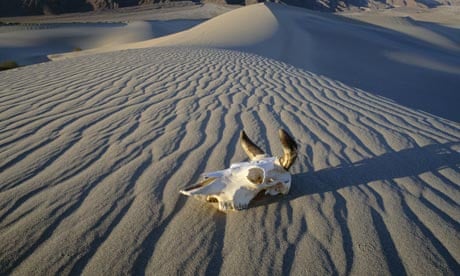Rain, wind and occasional ice might seem like routine March weather; but acting together they can produce unusual effects.
For most of the year Racetrack Playa in Death Valley, California is a dry lake, a perfectly flat expanse of cracked white clay. There are a few scattered stones on the surface, from a few centimetres in diameter to half a metre. Some of the stones have trails hundreds of metres long showing that they have moved across the ground – but how?
Nobody has seen one in motion, but geologists have tracked the stones progress for years, often in March.
The most likely explanation involves the spring weather. Rain and melting snow from the surrounding hills leaves many of the rocks partly-submerged in enormous, shallow pools. As temperatures fall at night, ice can form a collar around the base of a rock. This creates enough buoyancy for strong winds to overcome friction with the lake bed. This is only possible because of the flatness of the Playa, which allows wind to gust at 90 mph close to the ground.
A variation of this theory suggests that rather than just a collar, the stones are actually floated by ice rafts and moved by lighter winds.
In any case, the movement probably on lasts less than a minute and may only occur every several years. This is perhaps why the sailing stones of Racetrack Playa have remained one of the world's more elusive weather phenomena.

Comments (…)
Sign in or create your Guardian account to join the discussion